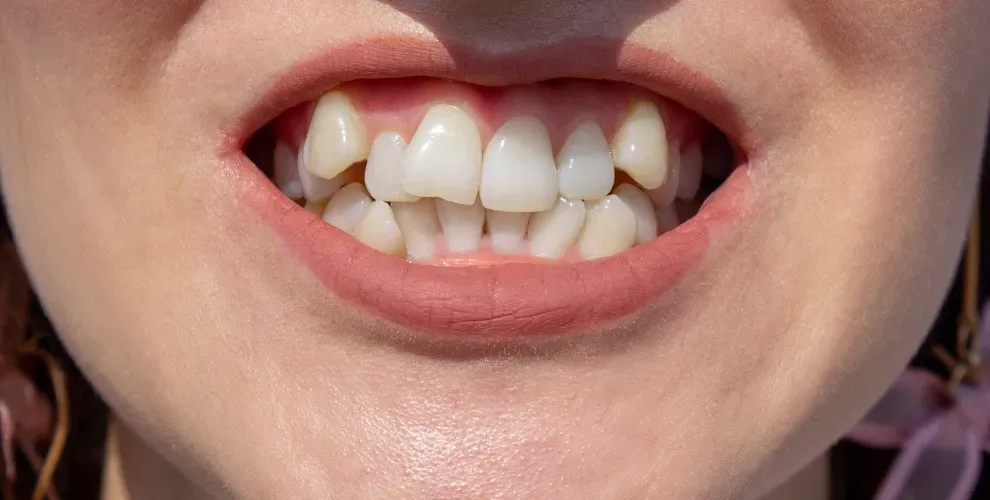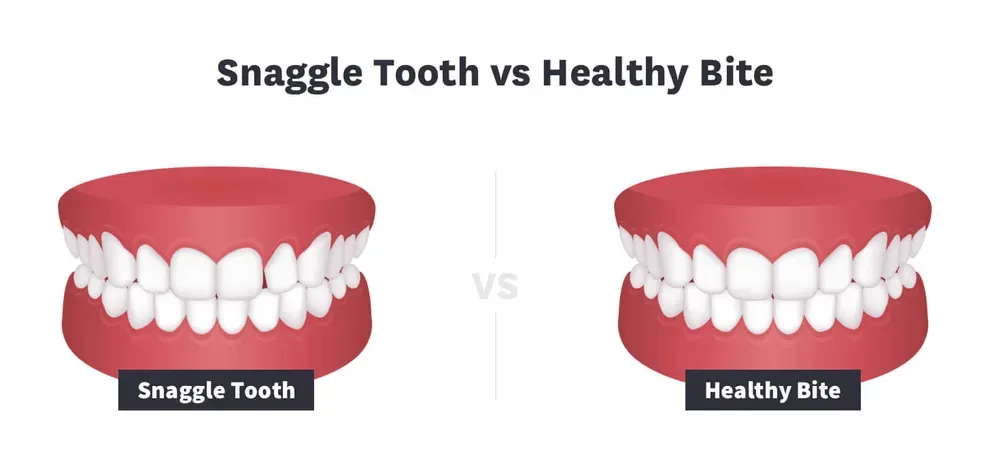How to Fix a ‘Snaggle Tooth’: Options, Costs & More.

Table of Contents
- Snaggle Tooth
- Complication of an Untreated Tooth
- Treatment Options & Costs
- Cost of Fixing a Snaggle Tooth
- Long-Term Options
- References
A tooth that is twisted, or pushed forward or behind the rest of your teeth, is sometimes referred to as a snaggle tooth.
You have a lot of options to fix a snaggle tooth, including braces, aligners, veneers, or tooth contouring.
What is a Snaggle Tooth?

A snaggle tooth is an irregular, odd-shaped, or projecting tooth that looks out of line compared to your other teeth.
This is simply a tooth that is misaligned with the others in your mouth. Perhaps it is turned at an angle while the others are not, or it may be pushed forward or behind your other teeth. A snaggle tooth may also be broken, giving it a pointy appearance.
Having a snaggle tooth may impact the way you feel about your smile. You may feel embarrassed about your appearance or self-conscious about how your mouth appears in photographs or in online meetings. Some countries prize a snaggle tooth as fashionable or beautiful, but in the United States, it is not considered part of an ideal appearance.
The presence of a snaggle tooth indicates that your teeth are crowded together. It may be a relatively easy situation to fix.
A snaggle tooth is a broken or crooked tooth that looks out of line compared to your other teeth and this can impact your confidence, but a snaggle tooth is relatively easy to fix.
Complications of an Untreated Snaggle Tooth
A snaggle tooth may impact more than just your self-confidence. Untreated, a snaggle tooth can also lead to the following issues:
Tooth decay and gum disease: A snaggle tooth can indicate your mouth has overcrowding. This means there may be hard-to-reach areas between teeth that are difficult to clean. Plaque and food particles may accumulate in these pockets and result in a buildup of bacteria that could lead to gum problems and decay.If your snaggle tooth is pointy or comes in contact with another area of your gum or inner mouth, this could also cause gum irritation and further inflammation.
Bad breath: Bacteria that gather in the pockets around your snaggle tooth, or in the areas between crowded teeth that are too hard to clean, may cause chronic bad breath.
Bite issues: Misaligned teeth can create unnatural wear patterns, stress on the teeth, and eventually damage like fractures or cracks.
Jaw problems: Crowded or misaligned teeth can put stress on the jaw and even cause headaches, neck and shoulder pain, and teeth clenching or TMJ disorders.
Ways to Fix a Snaggle Tooth and their Costs
Pediatric dentists monitor children’s teeth and will recommend braces, usually during the teenage years, to straighten the teeth. Even if you had braces as a teen, you may have alignment issues as an adult.
Your teeth continue to move throughout life because of genetics, wisdom tooth crowding, oral health, and various habits like smoking. It is normal for most people’s teeth to move, and increasingly, adults are turning to various options to improve the alignment of their teeth.
Here are some of the most popular options to fix a snaggle tooth or other crowding or alignment problems:

Braces use brackets that are attached to teeth and connected through bands. A wire runs through the bands and is adjusted and tightened to move teeth to their desired positions.
Traditional metal braces use noticeable metallic hardware, and they are used to correct many orthodontic issues. Because they are highly customizable and can be used with other hardware and most treatment plans, metal braces are considered the best way to fix severe alignment problems.For some severe cases of snaggle tooth, metal braces may be the only orthodontic option.
The cost of traditional braces ranges from $4,000 to $7,000.
Ceramic braces use white or tooth-colored brackets and wires to blend into teeth. “Invisible” braces are less noticeable, but they also have drawbacks. They can’t be used to correct every orthodontic issue, and they may be prone to staining and damage.
Ceramic braces are also slightly more expensive than traditional braces, with an average cost of $4,000 to $8,000.
Made from metal, these braces attach to your teeth through various bonding mechanisms, but they are behind your teeth rather than on the front. Because of their placement, they will not be visible to others.
There are downsides to lingual braces. You may speak with a lisp for the first few weeks. They are harder to adjust to. You will have to avoid certain foods like carrots, which can dislodge the braces.
Lingual braces are the most expensive of braces options. The average cost for this treatment ranges from $6,000 to $13,000, depending on the metal used, the skill of your dentist, the cost of living in your area, and how intricately the materials must be bonded to your teeth.
If your snaggle tooth is caused by a mild or moderate orthodontic issue, you may be an ideal candidate for clear aligners.
Clear aligners are removable and custom-made after a tooth scan or impression kit. The aligners fit over your teeth and are provided in a series. You’ll wear one aligner for about two weeks (usually for over 20 hours a day) before switching to a new one.
Each aligner tray is slightly different, and each is gradually moving your teeth into an ideal position. After the last tray, your teeth will be corrected, and your new smile will be ready.
Some aligner providers require in-office treatment. Others offer a completely remote treatment experience.
Byte, for example, offers an easy at-home impression kit to determine if you’re a candidate for aligners. If you are and decide to continue with treatment, you’ll then receive your aligners (along with Byte bonuses like a premium whitener and the HyperByte high-frequency massage device) and access to Byte’s mobile app for support throughout your doctor-monitored treatment.
You must comply with the aligner treatment plan, whether you choose traditional aligners or doctor-monitored, at-home aligners. If you do not wear the aligners for at least 22 hours per day, your teeth will not straighten properly.
The average treatment time for clear aligners is 6 months. At-home aligners cost approximately $900 to 2,500. In-office aligners may be more expensive, ranging from $3,000 to $8,000.
These are porcelain exteriors that are attached to your teeth. They are often used if one or two teeth are broken or slightly misaligned. These may also be used to improve the color of your teeth, making them whiter.
Veneers are customized to fit your teeth. They may need to be replaced over time since they will not last as long as a natural tooth.
One veneer can cost between $500 and $4,000. Getting four to six veneers for the top, front teeth, which is a common cosmetic procedure, can cost $2,000 to $24,000, depending on where you have this procedure completed. Since it is usually a cosmetic procedure, it is unlikely your dental insurance will cover the cost.
If your snaggle tooth is broken or juts out a little bit, but not much, tooth contouring may be an option to improve your overall appearance. Small amounts of the tooth will be shaved down, without destabilizing too much of the enamel.
This procedure is the least expensive, but it will not correct every type of snaggle tooth or address any underlying orthodontic issues.
Generally, the cost of tooth contouring ranges from $50 to $500, depending on how extensive the procedure needs to be. Since it is usually cosmetic, your dental insurance will not cover it. Rare cases may be medically necessary, like after an accident or injury that damages the tooth.
Cost of Fixing a Snaggle Tooth
| Snaggle Tooth Treatment | Cost | Is Dental Insurance likely to Provide Coverage for Treatment? |
|---|---|---|
| Traditional braces | $4,000–$7,000 | Yes |
| Ceramic (Invisible) braces | $4,000–$8,000 | Yes |
| Lingual braces | $6,000–$13,000 | No |
| At-home aligners | $900–$2,500 | Maybe |
| In-office aligners | $3,000–$8,000 | Maybe |
| Veneers | $2,000–$24,000 for a 4–6 tooth procedure | No |
| Tooth contouring | $50–$500 per tooth | No |
Best Long-Term Options for Fixing a Snaggle Tooth
The optimal method to correct your snaggle tooth depends on its severity as well as how the rest of your teeth are aligned. If you have a severe case of misalignment, including extensive bite issues, braces may be your best bet.
Doctor-monitored, at-home aligners are often the most effective and affordable option to correct minor to moderate issues, including a mild snaggle tooth. These plastic, customized teeth aligners are inexpensive. You can often pay in installments, and the treatment plan takes much less time than braces.
Aligners are significantly less invasive than surgeries or cosmetic procedures like veneers or tooth contouring.
